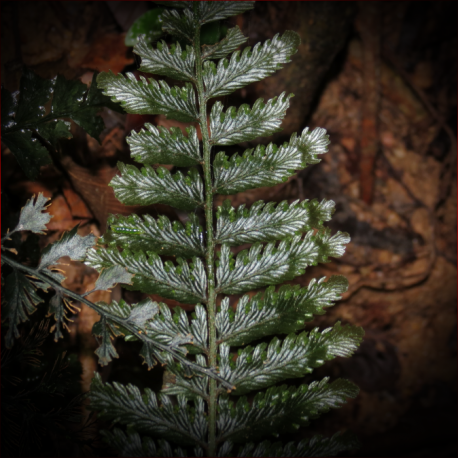More info
Datasheet
| Aquarium Compatible | no |
| Plant Outdoor | unknown |
General Description
Trichomanes javanicum, commonly known as "Aqua Fern" in the aquarium trade, is a fern species belonging to the Trichomanes genus within the Hymenophyllaceae family. Native to South-East Asia, particularly found along the banks of rivulets, this plant has stiff, dark green, and slightly transparent leaves. Unlike some similar species like Bolbitis heudelotii, T. javanicum does not produce a creeping rhizome; instead, it forms short upright shoots from which the rosette leaves grow. In its natural habitat, this fern develops mat-like structures with its roots on the substrate.
Aquarium Suitability
Despite its popularity in the aquarium trade and resemblance to other aquatic ferns, Trichomanes javanicum is not suitable for submersed cultivation. It is labeled as "not aquarium-compatible," which means it is not recommended for underwater usage in home aquariums.
Demands and Hardiness
The demands and hardiness of Trichomanes javanicum may vary depending on its cultivation as an outdoor or indoor plant. While specific details are not available, its natural habitat along rivulets suggests that it may thrive under semi-aquatic or moist conditions.
Aquascaping & Usage
Due to its inability to be cultivated fully submerged, Trichomanes javanicum does not lend itself well to traditional aquascaping in aquariums. However, its unique appearance and growth habits could potentially be utilized in paludariums or terrariums that mimic its natural rivulet-side environment.
Propagation
Information regarding the propagation of Trichomanes javanicum is not readily available. However, typical propagation methods for fern species include spore cultivation, division of rhizomes or root systems, or by plantlet formation at the tips of fronds.
Habitat and Distribution
Natively found in South-East Asia, *Trichomanes javanicum primarily grows in the vicinity of rivulets and water bodies. Its preference for moist environments along with the formation of mat-like roots on substrates contributes to its adaptation to these habitats. The species has not been reported to grow in regions beyond its natural distribution range.

